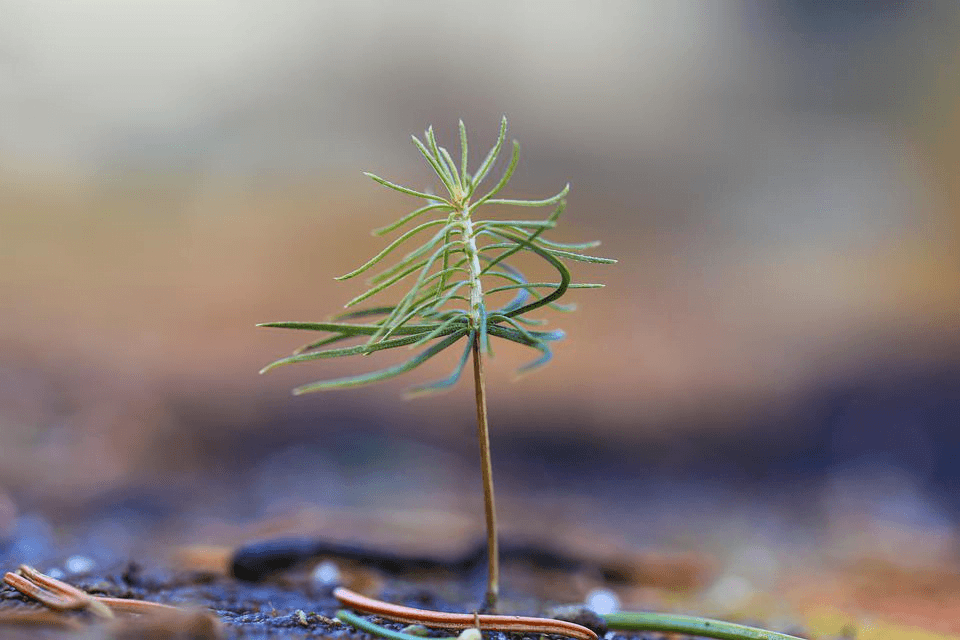Observing how a seed sprouts, it might lead to confusion regarding whether the subsequent tree’s growth occurs from its base or from the tip of the plant.
As a tree grows, it extends upward from the top of the stem, not the bottom. A plant grows taller from the activity of the shoot apical meristem which is found at the tip of the shoot.
If you want to know more about the magic that occurs while a tree is growing, read on!

What we cover
ToggleDo branches move up as a tree grows?
The commonest trees around you may not have hanging branches. You can only see the trunks at the bottom and the branches are hanging up high.
This is why many people get confused and conclude that the lower branches have grown up while the tree was growing from the bottom. This is not true and the truth is that most trees shed off their lower branches as they grow. This is due to many reasons such as:
- The lowest branches are the oldest branches that are already exposed to weather and pests for a long time. Thus, they’re more prone to death and decay than other branches on the tree. Once they start decaying, the trees shed them off to avoid spreading the decay to the tree trunk.
- Another reason why the lower branches fall off the tree trunk is due to insufficient sunlight. When a tree starts to have new branches, the sun rays are concentrated on these new branches, and the old branches are partially or totally blocked from receiving sunlight.
This leads to a reduction in their rate of photosynthesis and hence the death of such tree branches.
Secondary growth in shoots
If you perfectly understand how a tree grows tall and how the root gets longer, you may be wondering how it grows wider. The width of a plant is known as the girth and it is what is referred to as the secondary growth.
This secondary growth arises from the lateral meristems1 in the stems and roots of a tree. Similar to apical meristem, cell division occurs in the lateral meristem. Meanwhile, the lateral cell division gives rise to outward growth rather than upward or downward growth.
Eudicots experience cell division at the lateral meristem to increase their width but this is not obtainable in monocots. However, monocots do not experience secondary growth due to the presence of vascular cambium.
Primary growth in roots
The root system has an apical meristem2 which is also known as the root apical meristem. It works in a similar way to the shoots’ apical meristem by causing extension growth. The main difference between the root apical meristem and the shoot apical meristem is that the former causes growth toward the ground. Thus the growth and extension of the root are caused by the root apical meristem.
Functions of tree roots
The function of roots in a plant is highly significant. They anchor the plant firmly to the ground, absorb water and nutrients for the plant, store the excess nutrients, and also associate with soil microbes in symbiotic relationships.
Roots travel downward while they grow, dodging all obstacles on their way, with the root cap protecting the root apical meristem as the root makes its way through the soil. It also secretes a slimy ooze that lubricates the soil around its path to aid the root on its journey through the soil.
Types of roots
Roots can exist in different forms depending on whether the plant is a eudicot or monocot.
Eudicots
In eudicots, the first root to form is the primary root which grows straight down. It ends up being the dominant root otherwise known as the taproot. The taproot then produces lateral roots that extend out to the sides.
Common eudicots include tomato plants, roses, maple trees, oak trees, and raspberry bushes.
The branch roots (secondary roots) later join the taproot in its hunt for nutrients. The branch roots form from the pericycle. Branch roots do not grow as long as tap roots do, but they extend the plant’s water and nutrient intake from the ground.
Monocots
In monocots, the primary root usually dies immediately after the plant germinates and is replaced by roots called adventitious roots. These adventitious roots form on the stem of the plant.
Adventitious roots are lateral roots that anchor the plant. Instead of taproots, monocots have shallow, fibrous root systems that have the ability to trap a good amount of soil in monocots. Some examples of monocots are corn, orchids, lilies, and magnolias.
During the first stage of seed germination, it is very important for the young plant to get a firm grip on the ground. At the tender age of the plant, it tends to produce more roots than shoots, but as the plant gets older the amount of the root system is almost the same as the amount of the shoot system. Sometimes the underground root system equals the shoot system.
Do palm trees grow from the top or bottom?
Just like any other tree, Palm trees also grow from the top. By observing the growth pattern of a palm tree, it is easy to understand this. There is always a “spear” which represents new leaf growths clustered together.
The new growth is always covered by a white protective layer which is left on the palm frond after the new leaves have been pushed out. As the lower palm fronds get older and weaker, they eventually fall off and the newer ones will keep maintaining the tree.
- BD Editors, (2018) Lateral Meristem. <https://biologydictionary.net/lateral-meristem/> Accessed: 07-03-2024
- BD Editors, (2018) Apical Meristem. <https://biologydictionary.net/apical-meristem/> Accessed: 07-03-2024



